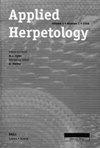Relative use of three types of artificial retreats by terrestrial lizards in grazed coastal shrubland, New Zealand
引用次数: 54
Abstract
Artificial retreats are increasingly used to sample animal populations and in attempts to boost animal numbers in degraded habitats. Understanding how animals use artificial retreats and which designs are most effective is therefore important. We tested the influence of retreat type, time-of-year and site on the use of artificial retreats by three species of terrestrial lizards (McCann's skink Oligosoma maccanni, common skink O. nigriplantare polychroma, and common gecko Hoplodactylus maculatus) in a remnant of grazed coastal shrubland at Birdlings Flat, New Zealand. Monthly capture sessions took place at two sites between December 2003 and November 2004. During 2160 retreat checks, 898 captures of 388 individual lizards were made. Geckos dominated the sample and displayed strong preferences for artificial retreats made of Onduline over corrugated iron and concrete tiles. Skinks used all types of artificial retreats without apparent preference. For all species, use of artificial retreats varied with time-of-year and was lowest in winter months. We also operated pitfall traps at these sites and made 329 captures of 205 individuals during 1920 trap-checks. Pitfall traps produced samples dominated by skinks. We conclude that Onduline retreats are a promising method for detecting terrestrial species of gecko in open habitats. Long-term studies are required to quantify the benefits of providing artificial retreats in restoration projects.三种类型的陆地蜥蜴在放牧的海岸灌木丛中人工撤退的相对使用,新西兰
人工撤退越来越多地用于对动物种群进行采样,并试图在退化的栖息地增加动物数量。因此,了解动物如何使用人工撤退以及哪种设计最有效是很重要的。本文在新西兰Birdlings Flat的滨海草地上,对三种陆生蜥蜴(McCann's skink Oligosoma macaccanni, O. nigriplantare polychroma)和普通壁虎(Hoplodactylus maculatus)进行了人工撤退类型、时间和地点的影响试验。2003年12月至2004年11月期间,每月在两个地点进行捕获。在2160次撤退检查中,捕获了898只蜥蜴,共计388只。壁虎在样本中占主导地位,并且对波纹铁和混凝土瓦片制成的人工退房表现出强烈的偏好。石龙子使用各种类型的人工撤退,没有明显的偏好。对所有物种来说,人工退殖地的利用随季节而变化,在冬季月份最低。我们还在这些地点设置陷阱,并在1920次陷阱检查中捕获了329只205只。陷阱产生的样本以石龙子为主。我们认为,在开放生境中,Onduline撤退是一种很有前途的检测陆生壁虎物种的方法。需要进行长期的研究,以量化在恢复工程中提供人工撤退的好处。
本文章由计算机程序翻译,如有差异,请以英文原文为准。
求助全文
约1分钟内获得全文
求助全文

 求助内容:
求助内容: 应助结果提醒方式:
应助结果提醒方式:


